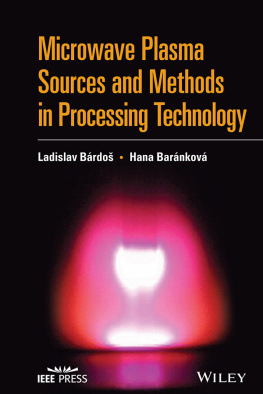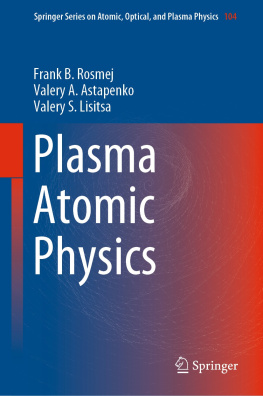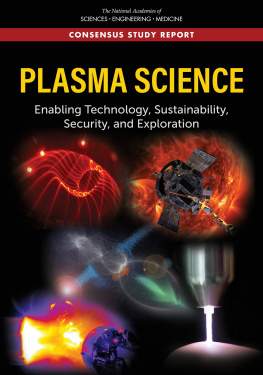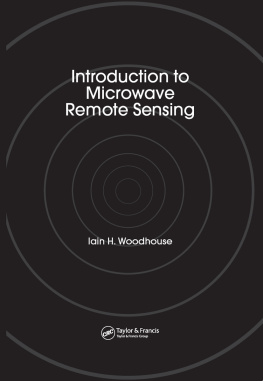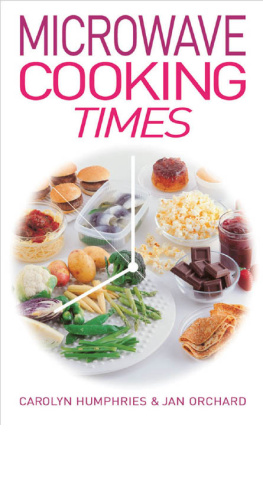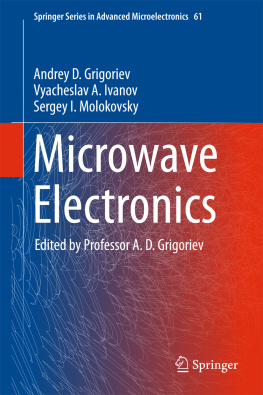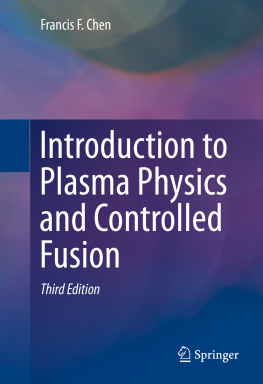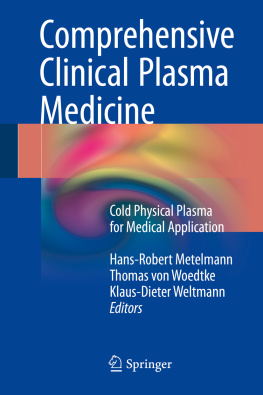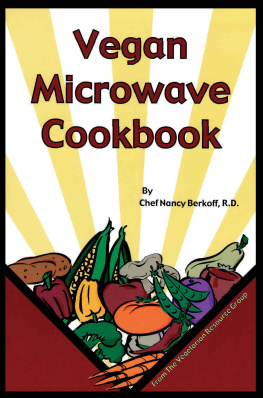
Microwave Plasma Sources and Methods in Processing Technology
Ladislav Brdo and Hana Barnkov
Uppsala University, Uppsala, Sweden
This edition first published 2022
Copyright 2022 by The Institute of Electrical and Electronics Engineers, Inc. All rights reserved.
Published by John Wiley & Sons, Inc., Hoboken, New Jersey.
Published simultaneously in Canada.
No part of this publication may be reproduced, stored in a retrieval system, or transmitted in any form or by any means, electronic, mechanical, photocopying, recording, scanning, or otherwise, except as permitted under Section 107 or 108 of the 1976 United States Copyright Act, without either the prior written permission of the Publisher, or authorization through payment of the appropriate per-copy fee to the Copyright Clearance Center, Inc., 222 Rosewood Drive, Danvers, MA 01923, (978) 750-8400, fax (978) 750-4470, or on the web at www.copyright.com. Requests to the Publisher for permission should be addressed to the Permissions Department, John Wiley & Sons, Inc., 111 River Street, Hoboken, NJ 07030, (201) 748-6011, fax (201) 748-6008, or online at http://www.wiley.com/go/permission.
Limit of Liability/Disclaimer of Warranty: While the publisher and author have used their best efforts in preparing this book, they make no representations or warranties with respect to the accuracy or completeness of the contents of this book and specifically disclaim any implied warranties of merchantability or fitness for a particular purpose. No warranty may be created or extended by sales representatives or written sales materials. The advice and strategies contained herein may not be suitable for your situation. You should consult with a professional where appropriate. Neither the publisher nor author shall be liable for any loss of profit or any other commercial damages, including but not limited to special, incidental, consequential, or other damages.
For general information on our other products and services or for technical support, please contact our Customer Care Department within the United States at (800) 762-2974, outside the United States at (317) 572-3993 or fax (317) 572-4002.
Wiley also publishes its books in a variety of electronic formats. Some content that appears in print may not be available in electronic formats. For more information about Wiley products, visit our web site at www.wiley.com.
Library of Congress Cataloging-in-Publication Data
Names: Bardos, Ladislav, 1947- author. | Barankova, Hana, 1951- author.
Title: Microwave plasma sources and methods in processing technology / Ladislav Bardos, Hana Barankova, Uppsala University, Uppsala, Sweden.
Description: Hoboken, New Jersey : John Wiley & Sons, 2022. | Includes bibliographical references and index.
Identifiers: LCCN 2021031913 (print) | LCCN 2021031914 (ebook) | ISBN 9781119826873 (hardback) | ISBN 9781119826880 (pdf) | ISBN 9781119826897 (epub) | ISBN 9781119826903 (ebook)
Subjects: LCSH: Electromagnetism.
Classification: LCC QC760 .B267 2022 (print) | LCC QC760 (ebook) | DDC 660/.044--dc23
LC record available at https://lccn.loc.gov/2021031913
LC ebook record available at https://lccn.loc.gov/2021031914
Cover image: Image courtesy of the authors
Cover design by Wiley
Set in 9.5/12.5pt STIXTwo Text by Integra Software Services, Pondicherry, India
Contents
List of Figures
- Chapter 1
- Chapter 2
- Chapter 3
- Chapter 4
- Chapter 5
- Chapter 6
List of Table
- Chapter 1
Guide
Pages
Foreword from the Authors
After our long research and development activities in Plasma science we can state that the plasma is a well controlled environmentally-friendly medium utilizing electric power and enabling the very-high temperature processes and low temperature reactions not available in other methods. This book is, therefore, intended to help the readers interested in the non-thermal gas discharge plasmas and their applications. The content is focused on the microwave-generated plasmas, which have specific properties due to relatively high frequency and which can be used in a number of non-conventional applications. Based on our experience, from university teaching and from communications with the industry people, no broad understanding exists of the microwave power and the microwave plasma systems. People know microwave ovens, but mostly for the heating of meals, and without understanding the principles and specifications of the microwave power. Little knowledge exists about different plasma systems and applications related to microwave power, even though there is apparently growing interest in this technology, mainly for new plasma chemical processes. A motivation for writing this book is based on the authors long experience with design and applications of several non-conventional systems and applications, which might stimulate readers when furthering their knowledge and when developing new systems.
The content of this book is composed of five basic parts, i.e. chapters..
We have no intention to write a textbook and start with explanations of basic microwave theories based on Maxwell equations. Excellent comprehensive monographies have been written about microwave engineering with all theories, simulation models, and details, including use of microwaves for generation of the plasma discharges, see e.g. [.
After an explanation of the functions of microwave components in the typical power lines for the microwave plasma generation, in ) in the United States.
contains appendices with description of symbols, abbreviations, units and values used in the individual chapters.
As mentioned, this book has no ambition to become a handbook or a textbook. We have written an easy text to inspire the readers and raise their interest in further studies and designs of novel systems, as well as to help readers in their experimental works with the microwave plasma and the microwave plasma-assisted applications.
References
- [1] D. M. Pozar: Microwave engineering, 2nd Ed., John Wiley & Sons Inc., New York, 1996.
- [2] J. C. Slater: Microwave electronics, D. Van Nostrand Company Inc., New York, 1951.
- [3] T. Moreno: Microwave transmission design data, Artech House Microwave Library, Boston, MA, 1989. ISBN 089006346X, 9780890063460.
- [4] L.S. Polak and Yu.A. Lebedev, eds.: Plasma Chemistry, Cambridge International Science Publishing, Cambridge, UK, 1998. ISBN 1898326223, 9781898326229.
- [5] M. Moisan and J. Pelletier, eds.: Microwave Excited Plasmas Vol. 4, 1st Ed., Elsevier Science, Amsterdam, Netherlands, 1992.
- [6] Yu.A. Lebedev, ed.: Microwave discharges: fundamentals and applications, Yanus-K, Moscow, 2001. ISBN 5-8037-00665.
- [7] O.A. Popov, ed.: High density plasma sources, Noyes Publications, Park Ridge, NJ, 1995. ISBN 0-8155-13771.
Basic Principles and Components in the Microwave Techniques and Power Systems
1.1 History in Brief From Alternating Current to Electromagnetic Waves and to Microwaves
The greatest discoveries and developments connected with the great names in the field of alternating current (AC) and related systems were already dated in the early nineteenth century, see []. However, an important basic invention was the battery, a source of electricity, disclosed by the Italian scientist Alessandro Volta in 1799. This simple source of a direct current (DC) allowed many important experiments with electricity. In 1820, Danish physicist Hans Christian rsted discovered an effect of electricity on the magnetic field and his findings were confirmed by the experiments of French physicists Andre-Marie Ampere and Franois Arago. The parallel wires with DC current visibly attracted or repelled each other according to the mutual current directions. However, in 1830, English scientist Michael Faraday discovered the ability to generate electricity by moving magnets and the corresponding principle of the electric induction. These new effects based on the electric induction inspired the Serbian-American electrical and mechanical engineer Nikola Tesla and led to his inventions of an alternating current generator which used a rotating magnetic field, the Tesla coil, the transformation of AC voltages to high voltages or vice-versa, as well as other inventions patented at the end of 1887. Besides his fundamental inventions, Tesla is considered a pioneer in radar technology, X-ray technology, and remote control.
Next page
